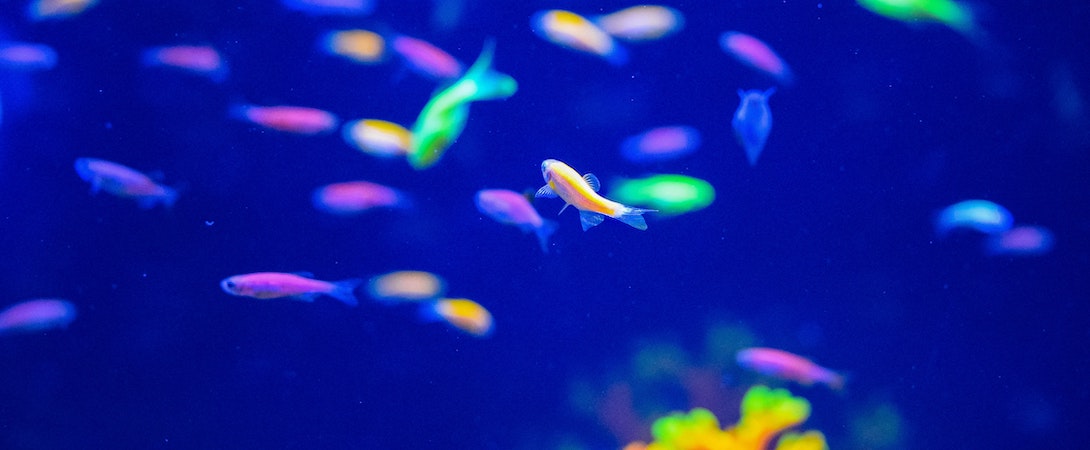New Evidence That Fishes Can Play
We have known for a long time that birds and mammals play. Increasingly, scientists are also finding evidence of play among amphibians, reptiles, and insects. For example, frogs wrestle together and ride air bubbles, turtles play tug-of-war, and alligators play with objects.
But do fishes play? Past studies have observed fishes engaged in seemingly silly, purposeless behaviors like pushing around twigs or trying to knock over objects. However, it has been difficult to determine if these peculiar actions were actually examples of play.
In this study, researchers used Gordon Burghardt’s five criteria for classifying play to observe how various fishes respond to red, green, and blue laser pointers:
- Unnecessary: To be considered play, the behavior must be unnecessary to the animal’s immediate survival.
- Voluntary: The behavior must be spontaneous, intentional, and performed for its own sake.
- Unique: The behavior may be similar to functional behaviors but must be somehow unique, either in context, incompleteness, exaggeration, or awkwardness.
- Repeated: The behavior should be repeated but not caused by mental or physical illness.
- Safe: The behavior should emerge in a safe environment, without stress, hunger, or apparent danger.
Over two weeks, they documented different species of fish at seven stores and one home aquarium, filming 10 hours of free-swimming and 10 minutes of laser pointer interaction. They classified the fishes’ responses to the lasers as either “none” (no behavior change), “some” (very brief change), “moderate” (showing interest in the laser for up to five seconds), or “high” (interacting for five seconds or more).
Of all the observed fishes, 88% showed mild to high interest in the lasers, with “some,” “moderate,” or “high” levels of interaction. Their three most common responses included general attentiveness/tracking, chasing, and biting/catching. Most fish species showed a preference for just the red laser, while only two species showed an exclusive preference for green lasers, and one species showed a preference only for the blue laser. Other fish species showed a preference for more than one laser (e.g., red and blue or red, green, and blue).
Behavioral differences emerged within and across species. For example, while most goldfishes ignored the laser pointer, one goldfish (who lived with tiger barb fishes) joined the tiger barbs in chasing down the laser.
The researchers found evidence of each criteria for play:
- Unnecessary: The fishes continued to chase the laser even after it was likely clear to them that it was not necessary for survival. While it might have been aggressive behavior, the authors compared it to the behavior of cats playing with laser pointers.
- Voluntary: The interaction was never forced or rewarded, so it was entirely voluntary.
- Unique: The fishes swam after the laser in quicker spurts and for longer periods than during their typical displays of aggression. They may have been examining the lasers as food or a threat, but it would have quickly become clear that the objects were neither. As a result, the play behavior resembled functional behavior with a different intent.
- Repeated: The behaviors were repeated but not “pathological” since the fishes began to lose interest after having ongoing exposure to the laser.
- Safe: All of the fishes in the study were healthy and well cared for, with no stressors added to their environment.
The authors acknowledge that it’s possible that these fishes were investigating a novel stimulus rather than truly playing, but they note that exploring new objects and environments is still a play-like behavior — like a baby exploring a new toy. So, do fishes play? We still can’t say for sure, but the evidence seems to point to yes.
People tend to see play as cute, which may trigger feelings of empathy. It’s hard to keep an emotional distance from living beings who engage in “human-like” behaviors. Cuteness is also a trigger for delight, eliciting the urge to pass on videos, photos, and stories of play — particularly if we’re surprised by a species’s playfulness.
Advocates can harness the power of cuteness by sharing images of animals at play, especially animals who people tend to empathize with least and consume most, like fishes and chickens. And of course, whenever you happen to interact with other animals, make some time to enjoy playing together!
https://www.mdpi.com/2076-2615/12/13/1684

















